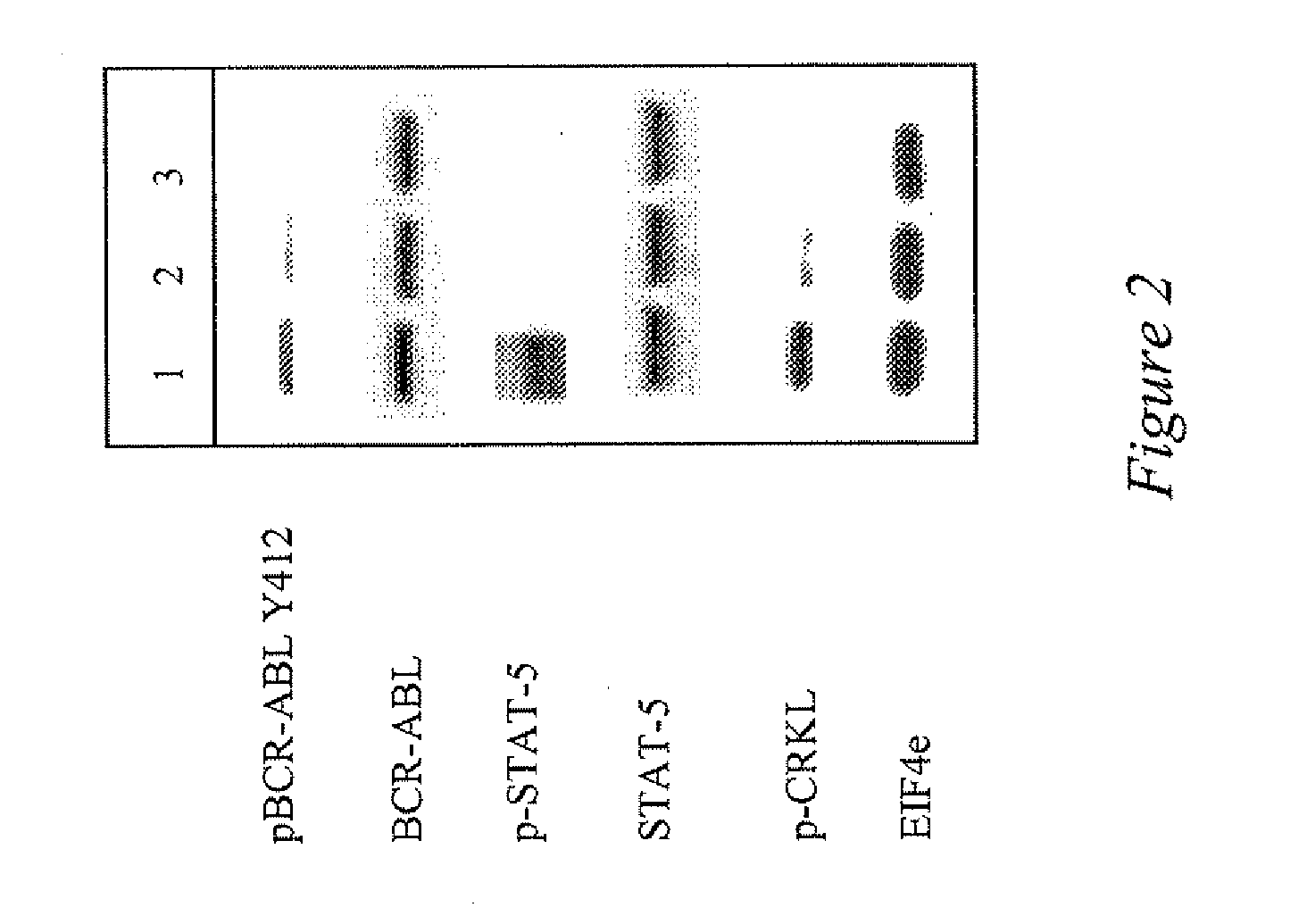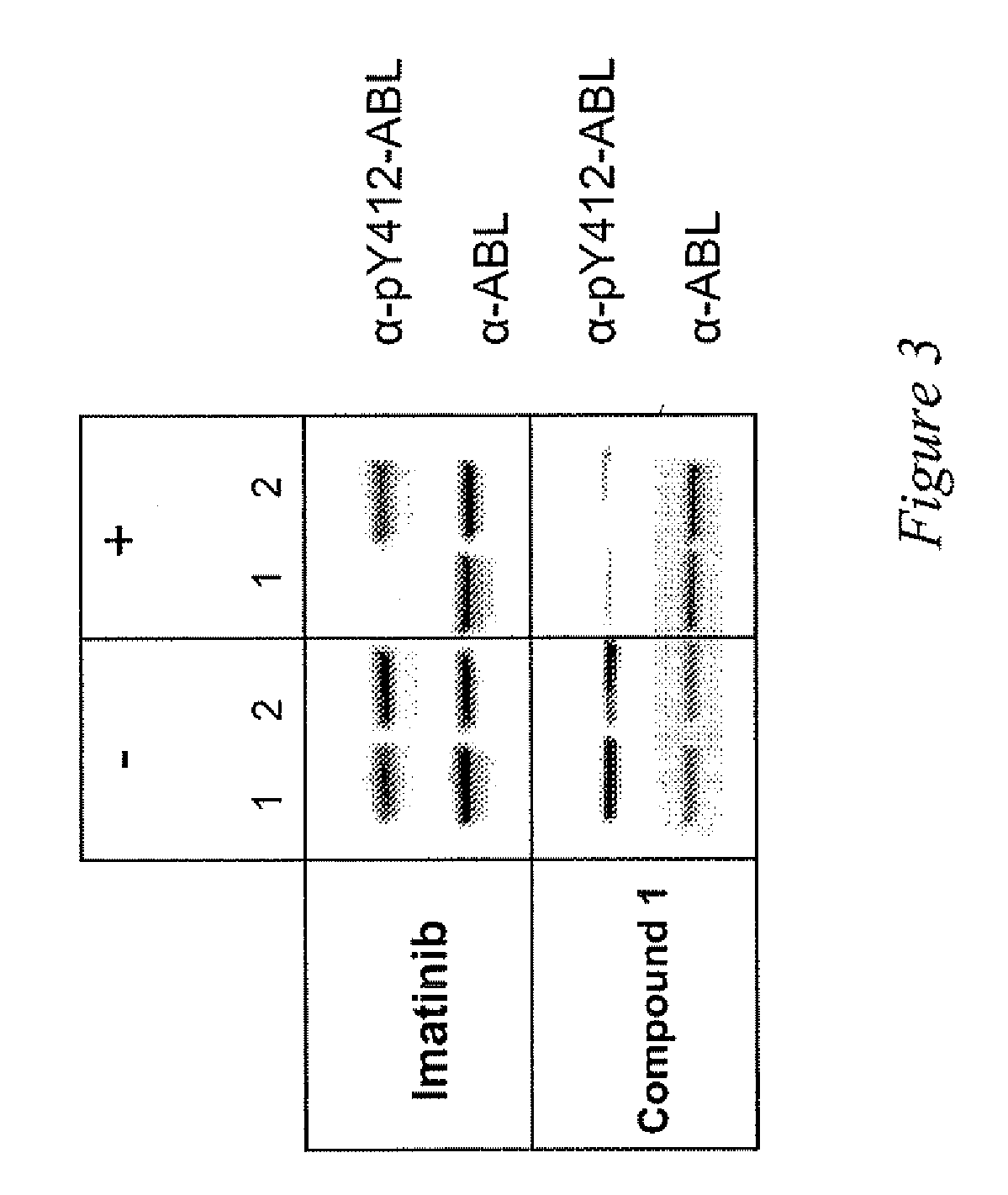Use of a kinase inhibitor for the treatment of particular resistant tumors
- Summary
- Abstract
- Description
- Claims
- Application Information
AI Technical Summary
Benefits of technology
Problems solved by technology
Method used
Image
Examples
example 1
Cloning, Expression and Purification of Recombinant Abl Kinase Domains
[0154]ABL kinase domain (corresponding to residues 229-512) was PCR amplified from a human testis cDNA library. Amplification was performed using the forward oligonucleotide:
[SEQ ID NO: 1]5′GGGGACAAGTTTGTACAAAAAAGCAGGCTTACTGGAAGTTCTGTTCCAGGGGCCCTCCCCCAACTACGACAAGTG-3′and the reverse oligonucleotide:[SEQ ID NO: 2]5′GGGGACCACTTTGTACAAGAAAGCTGGGTTTTATTTCCCCAGCTCCTTTTCCAC-3′
[0155]For cloning purposes, the oligonucleotides included attB sites in order to obtain an attb-flanked PCR product suitable for cloning using the Gateway® technology (Invitrogen). Furthermore, for purification purposes, forward primer included a PreScission® cleavage site (Amersham Biosciences). The resulting PCR product was cloned in the baculovirus expression vector pVL1393 (Invitrogen) Gateway®-modified. For expression and purification purposes, a GST tag was added N-terminal to the ABL kinase domain. Cloning was performed according to the prot...
example 2
[0158]Activity of compounds was evaluated in a gel-kinase assay that measures phosphorylation of myelin basic protein by recombinant wild-type and T315I mutant ABL kinase domains. Kinase assays were performed in a 20 μl of a reaction mixture containing 15 nM of recombinant enzyme, 10 μM of Myelin Basic Protein (Sigma-Aldrich) as substrate, 10 mM Hepes pH 7.5, 5 mM MgCl2, 1 mM MnCl2, 1 mM DTT, 15 nM Na3VO4, 4% DMSO, 3 nM ATP, 0.1 μCurie of γP32-ATP. Compound 1 and Compound 2 as defined above were tested and Imatinib was also tested in parallel as reference. The inhibitor concentration ranged from 10 nM to 10 μM. After preincubating enzyme and substrate with the inhibitor for 15 minutes at room temperature, ATP was added and reaction was carried on for 30 minutes at 30° C. and terminated with addition of get loading buffer and boiling for 5 minutes. Reaction mixtures were then loaded on a 10% SDS-polyacrilammide gel. After separation, gels were dried and radioactivity sign...
example 3
ATP Site-Dependent Displacement Assay Set-Up and Validation
[0160]An ATP-site dependent displacement assay was set-up for the quantitative affinity evaluation of the tested compounds.
[0161]The assay takes advantage of the significant increase in fluorescence intensity observed upon binding of indolinones to kinase proteins. Here below, we show the results obtained with two different indolinones, selected as potential probes on the basis of the magnitude of fluorescence increase upon binding to ABL.
3.1 Indolinone probe 2,4-dimethyl-5-[2-oxo-5-phenylmethanesulfonyl-1,2-dihydro-indol-(3Z)-ylidenemethyl]-1H-pyrrole-3-carboxylic acid (2-diethylamino-ethyl)-amide
[0162]Indolinone 2,4-dimethyl-5-[2-oxo-5-phenylmethanesulfonyl-1,2-dihydro-indol-(3Z)-ylidenemethyl]-1H-pyrrole-3-carboxylic acid (2-diethylamino-ethyl)-amide was evaluated for its ability to bind the wild-type ABL kinase domain and the T315I ABL mutant in a titration experiment. The assay performance (Z′ factor) as well as the dis...
PUM
| Property | Measurement | Unit |
|---|---|---|
| Molar density | aaaaa | aaaaa |
| Molar density | aaaaa | aaaaa |
| Molar density | aaaaa | aaaaa |
Abstract
Description
Claims
Application Information
 Login to View More
Login to View More - R&D
- Intellectual Property
- Life Sciences
- Materials
- Tech Scout
- Unparalleled Data Quality
- Higher Quality Content
- 60% Fewer Hallucinations
Browse by: Latest US Patents, China's latest patents, Technical Efficacy Thesaurus, Application Domain, Technology Topic, Popular Technical Reports.
© 2025 PatSnap. All rights reserved.Legal|Privacy policy|Modern Slavery Act Transparency Statement|Sitemap|About US| Contact US: help@patsnap.com



